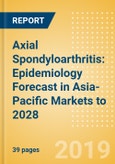Axial Spondyloarthritis: Epidemiology Forecast in Asia-Pacific Markets to 2028
Summary
The diagnosed prevalent cases of Axial Spondyloarthritis (AxSpA) are expected to increase from 6.1 million cases in 2018 to 8.0 million cases in 2028, at an annual growth rate (AGR) of 3.23% across the five growth markets (*5GM: Australia, China [urban], India, South Korea and Japan) in the Asia-Pacific (APAC) region. Of the 5GM (Australia, China [urban], India, South Korea and Japan), China (urban) is expected to have the highest number of diagnosed prevalent cases, increasing from 3.1 million cases in 2018 to 4.1 million cases in 2028. There were 2.8 million cases in India while Australia had 0.08 million diagnosed prevalent cases in 2018.
The major drivers for the upward trend in the diagnosed prevalent cases of Axial Spondyloarthritis (AxSpA) in the 5GM over the next decade is partly attributable to aging population combined with the increasing trend in the prevalence of the condition. Axial Spondyloarthritis (AxSpA) usually starts in the third decade of the life, and can have a major impact on patient health-related quality of life and work productivity. There is an unmet need for epidemiological studies to better understand the disease burden.
Axial Spondyloarthritis (AxSpA) is an insidious disease and difficult to diagnose. Diagnosis is aided by family history, clinical examination, C-reactive protein (CRP), HLA-B27 testing and radiographic imaging. Diagnoses of Axial Spondyloarthritis (AxSpA) patients have an average delay of eight years from the onset of symptoms.
The company’s latest report, ‘Axial Spondyloarthritis: Epidemiology Forecast in Asia-Pacific Markets to 2028,’ provides an overview of the risk factors and historical trends for axial spondyloarthritis across the 5GM in the ages ≥18 years.
Scope
Reasons to buy
The AxSpA Epidemiology series will allow you to -
Summary
The diagnosed prevalent cases of Axial Spondyloarthritis (AxSpA) are expected to increase from 6.1 million cases in 2018 to 8.0 million cases in 2028, at an annual growth rate (AGR) of 3.23% across the five growth markets (*5GM: Australia, China [urban], India, South Korea and Japan) in the Asia-Pacific (APAC) region. Of the 5GM (Australia, China [urban], India, South Korea and Japan), China (urban) is expected to have the highest number of diagnosed prevalent cases, increasing from 3.1 million cases in 2018 to 4.1 million cases in 2028. There were 2.8 million cases in India while Australia had 0.08 million diagnosed prevalent cases in 2018.
The major drivers for the upward trend in the diagnosed prevalent cases of Axial Spondyloarthritis (AxSpA) in the 5GM over the next decade is partly attributable to aging population combined with the increasing trend in the prevalence of the condition. Axial Spondyloarthritis (AxSpA) usually starts in the third decade of the life, and can have a major impact on patient health-related quality of life and work productivity. There is an unmet need for epidemiological studies to better understand the disease burden.
Axial Spondyloarthritis (AxSpA) is an insidious disease and difficult to diagnose. Diagnosis is aided by family history, clinical examination, C-reactive protein (CRP), HLA-B27 testing and radiographic imaging. Diagnoses of Axial Spondyloarthritis (AxSpA) patients have an average delay of eight years from the onset of symptoms.
The company’s latest report, ‘Axial Spondyloarthritis: Epidemiology Forecast in Asia-Pacific Markets to 2028,’ provides an overview of the risk factors and historical trends for axial spondyloarthritis across the 5GM in the ages ≥18 years.
Scope
- The Axial Spondyloarthritis Epidemiology Report provides an overview of the risk factors and global trends of AxSpA in the five growth markets (5GM: Australia, China [urban], India, South Korea, and Japan).
- Base Scenario: This report includes a 10-year epidemiological forecast for the diagnosed prevalent cases of AS and nr-AxSpA for both sexes and ages ≥18 years in the 5GM.
- Alternate Scenario: Additionally, a 10-year epidemiological forecast for the diagnosed prevalent cases of AS and nr-AxSpA segmented by age (18-19 years, 20-29 years, 30-44 years, 45-59 years, 60-74 years, 75-79 years, 80-84 years, and 85 years and older) and sex. The report also provides the forecast for diagnosed prevalent cases of AS segmented by HLA-B27 seropositivity status in the 5GM.
- The axial spondyloarthritis epidemiology report is written and developed by Masters- and PhD-level epidemiologists.
- The Epidemiology Report is in-depth, high quality, transparent and market-driven, providing expert analysis of disease trends in the 5GM.
Reasons to buy
The AxSpA Epidemiology series will allow you to -
- Develop business strategies by understanding the trends shaping and driving the global AxSpA market.
- Quantify patient populations in the global AxSpA market to improve product design, pricing, and launch plans.
- Organize sales and marketing efforts by identifying the age groups and sex that present the best opportunities for AxSpA therapeutics in each of the markets covered.
- Understand magnitude of AxSpA by radiographic and nonradiographic population.
Table of Contents
1 Axial Spondyloarthritis: Executive Summary
2 Epidemiology
List of Tables
List of Figures








